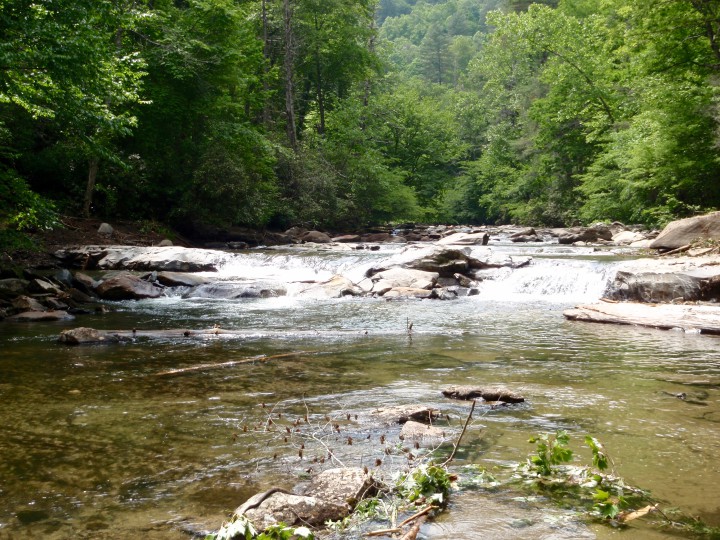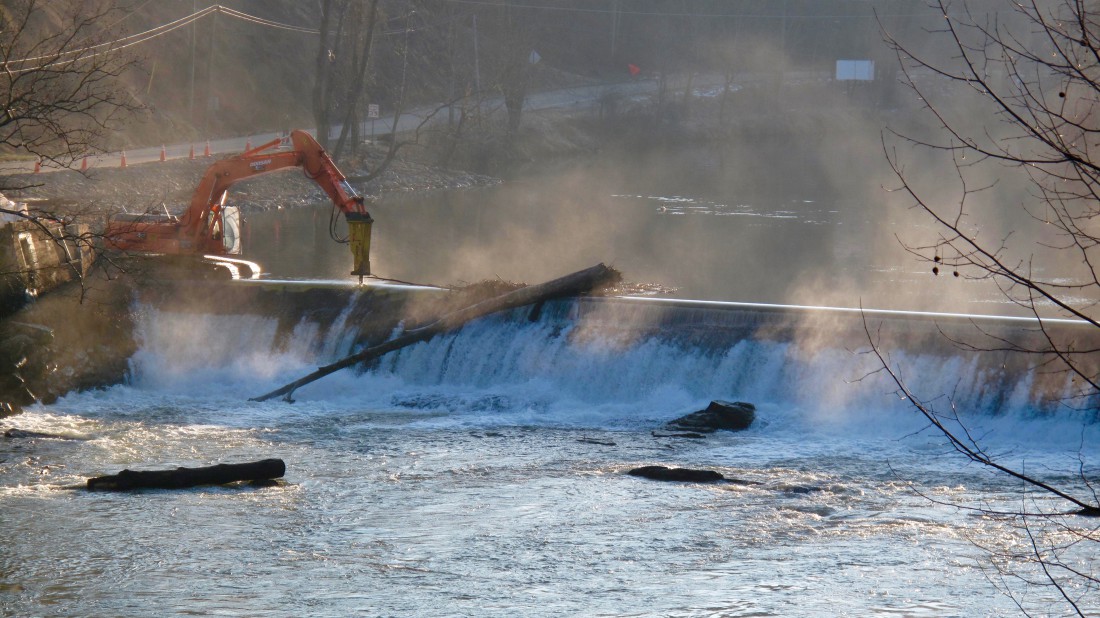In the mid-1960s, the U.S. Forest Service decided it had a problem with Santeetlah Creek, a stream in Nantahala National Forest to the southwest of Asheville. None of the usual suspects, such as bank erosion, industrial pollution or agricultural runoff, were at play. There were simply too many native fish.
“Anglers weren’t buying licenses to pursue those fish,” explains Jason Farmer, fisheries biologist for the Cheoah Ranger District of Nantahala National Forest. “Management agencies reasoned they should just get rid of the natives and replace them with non-native rainbow and brown trout, thinking that the native fish were competing for limited food.”
An 80-foot-long, 8-foot-high concrete barrier was erected across the creek to prevent native fish from swimming upstream; the water above the new dam was poisoned to kill off those that remained. Subsequent monitoring found that, while this dramatic intervention eliminated native smallmouth bass from the creek, it had no effect on overall trout numbers. Yet until 2017, the dam remained in place, a relic of an abandoned goal for the waterway.
The Santeetlah Creek fish barrier is far from a unique case, says Erin McCombs, conservation director for the Southern Appalachia region with American Rivers. “In North Carolina, we’re aware of over 6,300 dams on our streams, and many of these structures are no longer serving any purpose,” McCombs points out. Barriers once put up to provide power for grist mills or textile plants, for example, have lasted long after their associated industries moved away.
Nonprofits, community groups and government agencies throughout Western North Carolina are now working to remove this legacy of outdated dams. Although challenging, the process offers benefits for the wildlife, safety and recreation potential of the area’s waterways.

Healthy rivers run
Ecology provides the primary impetus for most dam removal projects. At the most basic level, eliminating these barriers allows native species to reach previously inaccessible habitats. “We have the highest freshwater species diversity in the country right here in the southeastern U.S.,” says Farmer. “We now manage our streams to give those species the greatest opportunity to persist and expand into other areas.”
Even when a species is already present both above and below a dam, removal can strengthen the health of the population through recombining genetically separate groups. Farmer says that this was the case for the hellbender salamander in Santeetlah Creek. When the Forest Service removed the dam, the two once-fragmented populations began mixing to mate. The additional diversity reduces inbreeding and improves the hellbender’s prospects in the area.
McCombs adds that humans derive direct benefits from dam removal as well. “When rivers have room to move, flooding becomes less dangerous in comparison with highly restricted rivers,” she says. Waterways with access to their natural floodplains may experience small floods more frequently, but these areas also slow and spread water overflows, reducing the risk of more catastrophic events.
Below the surface of the water, dams can create strong recirculating currents known as hydraulic rollers, which pose threats to those directly downstream. “A lot of people don’t realize the liability and risk that come with owning a dam,” says McCombs. “Even an Olympic swimmer wouldn’t be able to get out of the current that forms at the base of these dams.”
Removing dams eliminates these rollers, making the water safer for swimmers and paddlers. In addition, fewer drops of the water create less need to portage boats. “It becomes more accessible for families to get out and recreate on the stream,” McCombs says.
Clearing the way
However, these benefits come at a sizable cost: McCombs estimates that a small dam removal project can run anywhere from $15,000 to $150,000. About 75 percent of that total accounts for the actual dam demolition and stream restoration, while the remaining 25 percent covers the necessary design, engineering and permitting.
One of the largest expenses is the removal of the sediment that accumulates behind the dam over the course of its lifespan. Heavy equipment is usually necessary to dredge loads of muck from the streambed, and toxic waste disposal may be required for sediment associated with industrial dams. In especially vulnerable environments, endangered species surveys and relocation tack on further costs.
Even when funding is available, finding qualified staff to carry out the project poses its own challenge. “It’s a specialized activity — you need contractors trained in upstream restoration techniques and engineers that are familiar with the process,” says Farmer. Beyond removal of the dam itself, restoration of the stream’s original flow often requires additional planning to correct for erosion of the streambed.
In translating that plan into reality, dam removal projects can encounter unexpected difficulties. Farmer points to surges of stormwater runoff as a particular challenge to a process all about the control of water. “You can draw something up on paper that looks good, but once you get out there, conditions may necessitate a change of plans,” he says. “You just have to be flexible and adjust to the landscape.”
Stronger together
Given the many complications of dam removal, McCombs notes that the most successful projects involve collaborations between an array of groups with different expertise. “Most of my work is about cultivating partnerships,” she explains. “The beauty of this approach is that you can build a lot of capacity and momentum to get more projects done.”
Lynn Sprague, executive director of the Southwestern North Carolina Resource Conservation and Development Council, agrees with that assessment. In 2016, the organization began planning the removal of an old gristmill dam in the Beaverdam community of Canton. The project quickly expanded to include the town of Canton, Haywood Soil and Water Conservation District, Haywood Waterways Association and a number of other groups.
Involving community members is also key to success. “At our stakeholder meetings with the public, we found that people like to contribute the stories of the gristmill and give you some background on when they last saw it as an active dam,” Sprague says. By fostering that sense of connection with the project, his group developed good relationships with local landowners and got access to their property for much-needed measurements.
With local groups contributing project management and public engagement, larger organizations such as American Rivers have a much easier time accomplishing dam removals. “Having individuals that are integrated in a community is important to get a project to a place where we can move forward on it,” McCombs says. “We have to have a willing landowner on board, so finding people who understand the benefits of dam removal and can do that landowner outreach is crucial.”
Walls come tumbling
Momentum for dam removals is building, both in North Carolina and across the United States. The Forest Service found that 548 dams were removed throughout the country from 2010 through 2015, more than the combined total from 1920 through 2009. McCombs says American Rivers was involved in eight dam removal projects throughout the state in 2016, a record for the organization, and she estimates that a similar number will take place in 2018.
Local groups also have several projects planned for the upcoming year. Sprague says that the Southwestern North Carolina Resource Conservation and Development Council hopes to tackle a dam associated with an old icehouse on Shepherd’s Creek near Bryson City, while Farmer and the Forest Service plan to remove a log fish barrier in the Hiawassee River watershed.
For now, however, Farmer is watching for the Santeetlah Creek removal to bear fruit. “We’re hoping that smallmouth bass and other species can recolonize the blocked-off sections of the waterway,” he says. “I think a lot of people have come to realize that there is value in having that diversity.”




Good. Take out every man-made dam in America. Next up: Hoover Dam. No more dams!!
LOL good. And hydroelectric power, which is clean, will be gone too. But radical leftist assume that if one freezes to death because of a lack of heat, that’s the price to pay for progress lulz.
LOL we orbit a yellow dwarf star which could power our entire planet.
LOL how is that going to happen when people like Brownie enrich themselves off the taxpayer? Do you honestly believe the price of solar energy will come down when the government is being charged for them? Only in this area has someone risen to commission chair and made millions at the same time and never be questioned for it.
Economies of scale, duh.
The FBI tip line remains open if you have something other than insinuation.